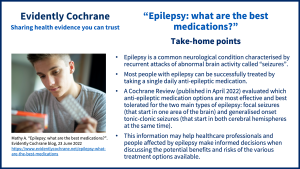In this blog for people making choices about epilepsy medication, Dr Alexandre Mathy, a neurology registrar at Oxford University Hospitals, explains what the latest Cochrane evidenceCochrane Reviews are systematic reviews. In systematic reviews we search for and summarize studies that answer a specific research question (e.g. is paracetamol effective and safe for treating back pain?). The studies are identified, assessed, and summarized by using a systematic and predefined approach. They inform recommendations for healthcare and research. tells us about which medications may be most effective and best tolerated for people with focal seizures or generalised onset tonic‐clonic seizures.
Take-home points:

What is epilepsy?
Despite being common (affecting about 1% of the global populationThe group of people being studied. Populations may be defined by any characteristics e.g. where they live, age group, certain diseases.), epilepsy remains a condition shrouded in mystery. The ancients called it the Sacred Disease, as epileptic fits were felt to be due to the Gods taking temporary control of the patient’s body. We now know that epilepsy is caused by abnormal synchronised activity in the brain causing attacks that we call seizures.
Seizures are short attacks typically lasting minutes. They can take many forms depending on where in the brain the abnormal activity occurs. A seizure arising from a structure in the brain called the temporal lobe might manifest as the patient experiencing déjà-vu and subtle involuntary movements such as lip smacking, and then losing awareness for a few minutes. These types of seizures that come from a restricted part of the brain are called “focal”.
Seizures affecting the whole brain at once are called “generalised” and will look like the more typical fits seen in Hollywood films, with loss of awareness and violent rhythmic movements of the limbs on both sides of the body.
Seizures can lead to injuries (for instance, fractures sustained during a seizure) and, uncommonly, death (called Sudden Unexplained Death in Epilepsy – SUDEP). They can also impact on patient’s daily life in other ways. For instance because of restrictions placed on their driving or placing limits on the types of work they can do.
How is epilepsy treated?
Fortunately, most people with epilepsy can be rendered completely seizure free with appropriate treatmentSomething done with the aim of improving health or relieving suffering. For example, medicines, surgery, psychological and physical therapies, diet and exercise changes.. For most people, this will be with antiepileptic drugs (AEDs). Indeed, over 50% of people with epilepsy can be seizure-free with a single drug.
The people who still have seizures despite drug treatment may be candidates for epilepsy surgery where the part of the brain causing the seizures is removed by a brain surgeon. The evidence for epilepsy surgery was summarised in a recent Cochrane review Surgery for epilepsy (published June 2019). Other treatment options include vagal nerve stimulation and a special diet called the “ketogenic diet”, which were also the subject of Cochrane ReviewsCochrane Reviews are systematic reviews. In systematic reviews we search for and summarize studies that answer a specific research question (e.g. is paracetamol effective and safe for treating back pain?). The studies are identified, assessed, and summarized by using a systematic and predefined approach. They inform recommendations for healthcare and research. (see Vagus nerve stimulation for partial seizures and Ketogenic diets for drug‐resistant epilepsy respectively).
What drug treatments are the best for treating epilepsy?
There are currently 27 medications licensed to treat epilepsy in the UK. This seems like an embarrassment of riches, but it can be overwhelming both to people and the doctors treating them. How to choose between the treatments?
Fortunately, there is now good evidence to support this decision. A recent Cochrane Review Antiepileptic drug monotherapy for epilepsy: a network meta‐analysis of individual participant data (published April 2022) looked at the clinical trialsClinical trials are research studies involving people who use healthcare services. They often compare a new or different treatment with the best treatment currently available. This is to test whether the new or different treatment is safe, effective and any better than what is currently used. No matter how promising a new treatment may appear during tests in a laboratory, it must go through clinical trials before its benefits and risks can really be known. comparing the 11 most commonly used AEDs and used a sophisticated statistical technique called a “Network Meta-analysisThe use of statistical techniques in a systematic review to combine the results of included studies. Sometimes misused as a synonym for systematic reviews, where the review includes a meta-analysis. ” to summarise this evidence and provide a ranking of the best treatments separately for focal and generalised epilepsy. The trials included adults and children.
Note that defining what the “best treatment” means is not as easy as it sounds: a treatment may be excellent at reducing seizures but cause such intolerable side effects that the patient can’t remain on it for long. Indeed, the review found that the oldest AEDs, phenobarbital and phenytoin, were the most effective at preventing seizures, but were poorly tolerated.
To incorporate side effects, the review ranked the treatments according to “time to treatment failure”, which takes into account whether a patient stopped a treatment due to it not working against the seizures, or stopped it due to side effects. Using this measure, they found reliable evidence that lamotrigine and levetiracetam were the best treatment for focal epilepsy.
For people with generalised epilepsy, there was moderate-certaintyThe certainty (or quality) of evidence is the extent to which we can be confident that what the research tells us about a particular treatment effect is likely to be accurate. Concerns about factors such as bias can reduce the certainty of the evidence. Evidence may be of high certainty; moderate certainty; low certainty or very-low certainty. Cochrane has adopted the GRADE approach (Grading of Recommendations Assessment, Development and Evaluation) for assessing certainty (or quality) of evidence. Find out more here: https://training.cochrane.org/grade-approach evidence for sodium valproate being the best for seizure control, with lamotrigine and levetiracetam in second place. Note however that sodium valproate is associated with a relatively high riskA way of expressing the chance of an event taking place, expressed as the number of events divided by the total number of observations or people. It can be stated as ‘the chance of falling were one in four’ (1/4 = 25%). This measure is good no matter the incidence of events i.e. common or infrequent. of developmental problems in babies of mothers taking the drug during pregnancy. Therefore women of childbearing ages will usually be recommended one of the alternative drugs.
AEDs vary widely in their side effectAny unintended effect (e.g. dizziness or a headache) of an intervention such as a drug, surgery or exercise. profile, but the most commonly reported side effects across all drugs were drowsiness, fatigue, headaches, gastrointestinal disturbances, dizziness, faintness and skin disorders.
What does this mean for people with epilepsy?
The evidence above provides a good starting point to choose a medication for the main types of epilepsy. The drugs mentioned above have therefore been incorporated in the NICE guidelines for epilepsy as first-line choices.
However, every person with epilepsy is different, which is why they should be under the care of a neurologist with expertise in treating this condition. It is not just the efficacyThe extent to which an intervention (for example a drug, surgery, or exercise), produces a beneficial result under ideal conditions. of the AED which will inform the choice of treatment. Other factors will be taken into consideration. For example, interactions of the AED with the person’s existing medications or other medical conditions, and the person’s preferences and priorities.
It is not uncommon for people with epilepsy to find they don’t do well on one of the first-line drugs and need to work down the list of other medications.
While this initial phase of finding the right treatment can seem laborious and frustrating, it is worth remembering that it is likely to end in a well-tolerated treatment which keeps the person with epilepsy completely free from seizures and able to reach their full potential.
Resources for people with epilepsy:
Join in the conversation on Twitter with @CochraneUK or leave a comment on the blog.
Please note, we cannot give specific medical advice and do not publish comments that link to individual pages requesting donations or to commercial sites, or appear to endorse commercial products. We welcome diverse views and encourage discussion but we ask that comments are respectful and reserve the right to not publish any we consider offensive. Cochrane UK does not fact check – or endorse – readers’ comments, including any treatments mentioned.
Alexandre Mathy is employed as a neurology registrar by NHS and has a Wellcome Trust Clinical Research Career Development Fellowship, employed by Oxford University Pharmacology department.



My 16 year old son has staring seizers and generalized grand Mal he takes lamotgrine and colazaban with both he still has onset seizers he was on depokate for a few years being seize free then horrible side effects accord I see this med is for adults only
Hi Shannon, my name is Amy. I have 2 boys w/ epilepsy, my 17 yo was diagnosed w/ focal epilepsy 3 years ago in Dec. , took Keppra w/ horrible side effects ( Rage, depression, derealization, couldn’t eat etc ) he was on 500 mg which was way more than he should have been given to begin w/ & I know this because he never had another grand mall seizure after the initial lower dose. He just switched to 100 mg of lamotrigine & is seizure free w/ no side effects. My 10 yo was diagnosed a year ago in Dec, w/ generalized epilepsy, he was put on Keppra & made his seizures worse so switched to lamotrigine, he’s on 450 mg & still has his seizures so now we’re supposed to switch to the V Acid & I’m concerned about the possible side effects .
I am a patient with generalized seizures currently taking Dilantin for over 10 years now. I have been seizure free since 2014, which was provoked by the stress and lack of sleep while taking care of my very ill mother. My neurologist has been wanting me to try a new medication because of the long term side effects, which I am experiencing now with swollen and bleeding gums. The last medication I tried was zonisamide that increased my blood pressure to a dangerous level. My question is what should I try? Will my gum issue improve once I am off the Dilantin?
I’m afraid we can’t give medical advice. You may like to read our blog Making health decisions: things that can help https://www.evidentlycochrane.net/making-health-decisions-things-that-can-help/ which has useful resources and offers some questions that can be helpful to discuss with your doctor.
Best wishes
Sarah Chapman [Editor]
I took Dilantin and it screwed up my gums but if that is the only side effect stick with and every 2 years treat yourself to some dental work